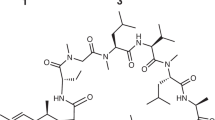Abstract
To simplify a nuclear magnetic resonance (NMR) spectra of the targeted molecules, spin–spin decoupling and selective isotope substitution are two distinct approaches. A third one is to increase the applied magnetic field to increase the frequency dispersion of the chemical shift range. While this is a viable option for NMR spectrometers with superconducting magnets, the new generation of compact NMR spectrometers employs permanent magnets with limited variety in field strengths between one and two Tesla. The low-frequency dispersion at these field strengths gives rise to higher order spectra more frequently than at high field. These low-field spectra can be simplified using lanthanide shift reagents, which form complexes with the substrate molecule and increase the frequency dispersion. In this work, the use of lanthanide shift reagents is demonstrated by means of one-dimensional 1H and 19F as well as two-dimensional 19F-19F COSY experiments using a new-generation compact NMR spectrometer.










Similar content being viewed by others
References
R. Ernst, G. Bodenhausen, A. Wokaun, Principles of Nuclear Magnetic Resonance in One and Two Dimensions (Clarendon Press, Oxford, 1990)
S. Berger, S. Braun, 200 and More NMR Experiments, 3rd edn. (Wiley-VCH, Weinheim, 2004)
H. Friebolin, Basic One- and Two-Dimensional NMR Spectroscopy, 5th edn. (Wiley-VCH, Weinheim, 2011)
T.D.W. Claridge, High-Resolution NMR Techniques in Organic Chemistry (Elsevier, Amsterdam, 2009)
E. Boltegar, M. Petrinovic, M. Sedlacek, J. Phys. E. Sc. Instrum. 1, 323 (1968)
B. Blümich, Trends Anal. Chem. (2016). doi:10.1016/j.trac.2015.12.012
B. Blümich, S. Haber-Pohlmeier, W. Zia, Compact NMR (de Gruyter, Berlin, 2014)
B. Blümich, in Encyclopedia of Analytical Chemistry (Wiley, Chichester, 2016). doi:10.1002/9780470027318.a9458
K. Singh, B. Blümich, Trends Anal. Chem. (2016). doi:10.1016/j.trac.2016.02.014
R.V. Ammon, R.D. Fischer, Angew. Chem. Int. Ed. 11, 675 (1972)
R.E. Sievers, Nuclear Magnetic Resonance Shift Reagents (Academic Press, New York, 1973)
M.E. Kenney, J.E. Maskasky, J. Am. Chem. Soc. 93, 2060 (1971)
C.D. Schaeffer Jr., C.H. Yoder, J. Chem. Educ. 62, 537 (1985)
A.J. Dale, Acta. Chem. Scand. B. 30, 255 (1976)
K.C. Yee, W.G. Bentrude, Tetrahedron Lett. 12, 2775 (1971)
T.J. Wenzel, J.D. Wilcox, Chirality 15, 256 (2003)
A.J. Rafalski, J. Barciszewski, M. Wiewiorowski, Tetrahedron Lett. 12, 2829 (1971)
A.F. Cockerill, D.M. Rackham, Tetrahedron Lett. 11, 5149 (1970)
E. De Boer, H. Van Willigen, Prog. Nucl. Magn. Reson. Spectrosc. 2, 111 (1967)
A. Orzeszko, B. Kamińska, G. Orzeszko, B.J. Starościak, II Farmaco. 55, 619 (2000)
A. Orzeszko, B. Kamińska, B.J. Starościak, II Farmaco. 57, 619 (2002)
T. Ishizone, H. Tajima, S. Matsuoka, S. Nakahama, Tetrahedron Lett. 42, 8645 (2001)
N. Kolocouris, G. Zoidis, G.B. Foscolos, G. Fytas, S.R. Prathalingham, J.M. Kelly, L. Naesens, E. De Clercq, Bioorg. Med. Chem. Lett. 17, 4358 (2007)
C.C. Hinckley, J. Am. Chem. Soc. 91, 5160 (1969)
G. Wahl Jr., M.R. Peterson Jr., J. Chem. Soc. D Chem. Commun. 18, 1167 (1970)
M.R. Dintzner, C.R. Kinzie, K. Pulkrabek, A.F. Arena, J. Chem. Educ. 89, 262 (2012)
I. Mamedov, R. Abbasoglu, M. Bayramov, A. Maharramov, Magn. Reson. Chem. 54, 315 (2016)
M. T. Musser, in Cyclohexanol and Cyclohexanone, Ullmann’s Encyclopedia of Industrial Chemistry. doi:10.1002/14356007.a08_217.pub2
N. Akiya, P.E. Savage, Ind. Eng. Chem. Res. 40, 1822 (2001)
J.K.M. Sanders, D.H. William, J. Chem. Soc. D Chem. Commun. 422 (1970)
P.V. Demarco, T.K. Elzey, R.B. Lewis, J. Am. Chem. Soc. 92, 5734 (1970)
J.T. Groves, M. Van Der Puy, Tetrahedron Lett. 16, 1949 (1975)
Acknowledgments
We gratefully acknowledge Master’s student Anne Nickel for her kind help in performing the experiments and the financial support from Deutsche Forschungsgemeinschaft (DFG Gerätezentrum Pro2NMR), a DFG supported, joint instrumental NMR facility BL 231/46-1 of RWTH Aachen University and KIT Karlsruhe.
Author information
Authors and Affiliations
Corresponding author
Rights and permissions
About this article
Cite this article
Singh, K., Blümich, B. Compact NMR Spectroscopy with Shift Reagents. Appl Magn Reson 47, 1135–1146 (2016). https://doi.org/10.1007/s00723-016-0821-5
Received:
Revised:
Published:
Issue Date:
DOI: https://doi.org/10.1007/s00723-016-0821-5




